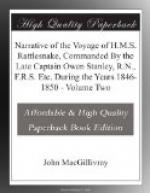(Footnote. In further illustration of this assertion I give the following note with which I have lately been furnished by Mr. J. Sweatman, R.N., who served in the Bramble at the time of the occurrence of the murder to which it alludes. In June 1846 the supercargo and a boat’s crew of a small vessel from Sydney procuring trepang and tortoise-shell in Torres Strait, landed upon Mulgrave Island (the vessel being about seven miles off) in order to barter for tortoise-shell. The natives appeared at first to be friendly enough, but, towards evening some circumstances occurred which induced the boat’s crew to re-embark, and they then went to a small sandbank about a mile off to pass the night there. The supercargo and three men landed, leaving two men in the boat at anchor; about midnight the latter were alarmed at hearing shouts and yells on shore, and, landing in haste, found that the natives had attacked their comrades, whose muskets being damp, were quite useless. The supercargo and two men were killed—a shot from the boat however dispersed the natives sufficiently for the two men to drag their surviving comrade into the boat, but he had an arrow through the body, and his hands were partially severed, and he soon died. The bodies of the three people on the sandbank could not be recovered, the natives returning to the attack with showers of arrows, nor could the small force on board the schooner attempt to punish the perpetrators of this unprovoked murder.)
The inhabitants of the neighbouring Banks Island are described by Giaom as evincing the same hostility towards Europeans. Only a few years ago the Italegas, one of the two tribes inhabiting that island, murdered two white men and a boy, who had reached their inhospitable shores in a small boat, probably from a wreck. Such savage outrages committed by the inhabitants of the north-western islands would probably be completely prevented were they oftener visited by Europeans; such was the case with the people of Darnley Island, once dangerous savages, now safely to be dealt with by taking the usual precautions, and where, as at the Murray Islands, I believe strangers in distress, without valuable property, would now be kindly treated.
INTERCOURSE WITH CAPE YORK NATIVES.
We remained nine weeks at our anchorage in Evans Bay. The natives, of whom there were usually a number encamped in the neighbourhood, attracted by the presence of the ship, as vultures by a carcass, continued on perfectly friendly terms, assisted the wooding and watering parties, brought off fish and portions of turtle to the ship, and accompanied us on our walks on shore. The usual remuneration for their services was biscuit, and, next to that, tobacco, besides which axes and knives were highly prized and occasionally given them. Immediately on landing for the purpose of an excursion, each of us looked out for his kotaiga* from among a crowd of applicants surrounding the boat, the haversack




